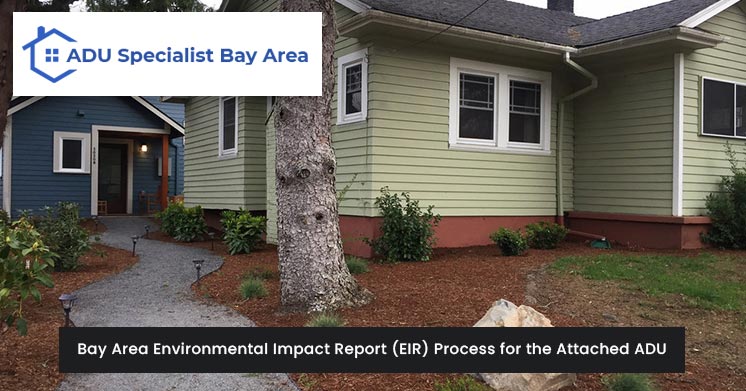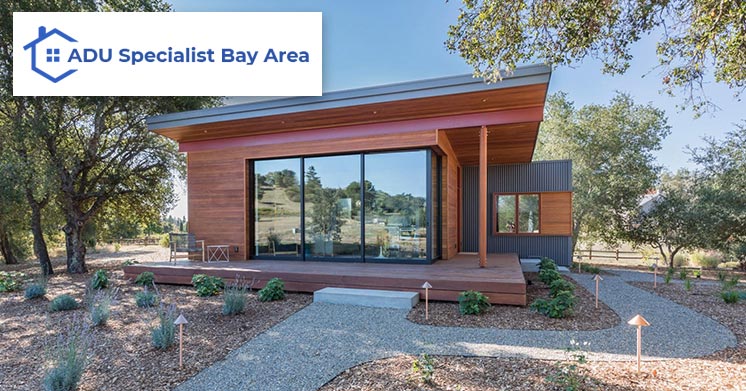- Call Free: 877-937-7970
Environmental Impact Report (EIR) Process for the attached ADU is critical for assessing and mitigating any potential environmental impacts of an attached ADU project.

This process becomes even more critical when working with ADU Specialists Bay Area familiar with the region’s unique environmental challenges and regulations.
The Environmental Impact Report (EIR) process evaluates the environmental impacts of proposed development projects, such as attached ADUs.
The process involves identifying potential impacts, analyzing their significance, and developing mitigation measures. The EIR also evaluates alternative project designs and involves public comment and review by government agencies.
The EIR process aims to provide decision-makers with relevant and accurate information about the project’s environmental impacts and potential benefits and costs.
By doing so, the EIR process facilitates informed decision-making that considers the potential environmental impacts of the proposed attached ADU while also allowing for identifying and implementing appropriate mitigation measures to reduce or eliminate any adverse effects.
The EIR process for an attached ADU typically involves the following steps:
The Environmental Impact Report (EIR) process for attached ADUs is subject to various laws and regulations.

CEQA is a state law requiring public agencies to identify the significant environmental impacts of their actions and avoid or mitigate them whenever feasible. The EIR process for attached ADUs must comply with CEQA, and an EIR or other environmental documentation may be required.
Local zoning regulations, such as city or county General Plans, Specific plans, and Zoning ordinances, set the jurisdiction’s land use policies, goals, and standards. The EIR process for attached ADUs must comply with the applicable zoning regulations.
The construction of attached ADUs must comply with the California Building Codes, which provide the standards for construction, safety, and occupancy.
Other environmental regulations, such as the National Environmental Policy Act (NEPA), may apply to the EIR process for attached ADUs.
State and local laws governing ADUs may also apply to the EIR process for attached ADUs. For example, California State Law AB 68, AB 881, SB 13, and AB 670 provide standards for ADU construction, size, and location.
| Environmental Impacts | Description |
| Traffic and parking impacts | The presence of an additional dwelling unit may increase traffic in the area, leading to increased emissions and congestion. |
| Air quality impacts | The attached ADU’s construction activities and operation of the attached ADU may produce dust, exhaust fumes, and other air pollutants that can affect air quality. |
| Noise impacts | The construction and operation of the attached ADU may generate noise that could disturb nearby residents. |
| Water quality impacts | The attached ADU may increase the number of impervious surfaces, such as driveways and roofs, which can result in increased stormwater runoff and potential pollutants entering the water supply. |
| Energy and Resource Use | The attached ADU may increase the area’s energy and resource use, including water and electricity. |
| Biological resources | The construction and operation of the attached ADU may disturb or impact the habitat of plants and wildlife in the area. |
| Cultural and historic resources | The attached ADU may be located in an area of cultural significance or have cultural resources on the property that must be protected. |
We invite readers interested in the Environmental Impact Report (EIR) process for attached ADUs in the Bay Area to call us. As ADU specialists in the Bay Area, we are committed to ensuring that the impact of our work is considered in the decision-making process and that sustainable development practices are promoted.
Transportation demand management strategies, Stormwater management practices, Energy-efficient design and construction, and Use of low-impact materials and methods.
The California Environmental Quality Act (CEQA) sets the EIR requirements.
An EIR is required for projects that may significantly affect the environment. The lead agency determines if an EIR is required based on the project’s potential impacts and the requirements of the California Environmental Quality Act (CEQA).
The applicant or project proponent typically prepares the initial draft of the EIR. However, the lead agency is responsible for reviewing and certifying the EIR before taking action on the proposed project.
The length of the EIR process varies depending on the complexity of the project and the potential environmental impacts. The process typically takes several months to over a year to complete, from the notice of preparation to the certification of the final EIR.